Application of Industrial Internet for Equipment Asset Management in Social Digitalization Platform Based on System Engineering Using Fuzzy DEMATEL-TOPSIS
Abstract
1. Introduction
2. Status Review for Industrial Internet and EAM
2.1. Related Concepts
2.1.1. Industrial Internet
2.1.2. Equipment Asset Management (EAM)
2.1.3. Smart Product Service System (SPSS)
2.1.4. Social Digitalization Platform (SDP)
2.1.5. The Relationship between Industrial Internet, EAM, SPSS, and SDP
- (1)
- The relationship between industrial internet and EAM
- (2)
- The relationship between Industrial Internet, EAM, and SPSS
- (3)
- The relationship between Industrial Internet, EAM, SPSS, and SDP
- (4)
- What are the benefits of SDP for EAM?
2.2. Status of Key Technologies for EAM
2.3. Status of Industrial Application for EAM
3. Research Methodology
3.1. Method of System Engineering Analysis
- (1)
- Step 1: Clear the questions (from trends and visions to demands)
- (2)
- Step 2: Select the objectives (from demands to goals and measurement criteria)
- (3)
- Step 3: System synthesis (from goals to investigations and plans in detail)
- The first stage was to summarize and analyze the existing literature on Industrial Internet-based technologies and solutions for Equipment Asset Management (Section 2.2 and Section 2.3) and deduce the application status of I3EAM in different industries.
- The second stage was to perform a detailed on-site investigation of the digitalization platforms and enterprises in different industries and analyze the industrial demand of I3EAM to obtain its constituent elements, functional modules, and their interaction relations.
- The third stage was to plan and design the general model and the reference architecture of co-implementation path, which leverage the research results of the system architecture of Industrial Internet. This stage is the most crucial stage, which is divided into six sub-steps as follows:
- Sub-step 1: Planning for the resource and edge layer of I3EAM;
- Sub-step 2: Planning for the infrastructure and platform layer of I3EAM;
- Sub-step 3: Planning for the big data engine layer of I3EAM;
- Sub-step 4: Planning of the modelling and simulation layer of I3EAM;
- Sub-step 5: Planning of the information model for integration and collaboration layer of I3EAM;
- Sub-step 6: Planning of the organization, business, and service layer of I3EAM.
- The fourth stage was to select the representative enterprises in typical areas as a case study and verify the reference model and detailed implementation steps of I3EAM, while helping those enterprises with the digitalization solution to achieve a top-level design and platform partner selection. Finally, the customized I3EAM usually can achieve industrial profit from operation cost reductions or the expansion of service capacities.
- (4)
- Step 4: System analysis (from designed system to performance metrics)
- (5)
- Step 5: Scheme collection (to collect and compare the I3EAM based on different SDPs according to the needs of the special enterprise)
- (6)
- Step 6: Make a decision (to select an SDP partner for co-implementation with a group decision-making process)
- (7)
- Step 7: Put it into practice (to customize and co-implement the I3EAM, and to build feedback mechanisms between the industrial practices and the reference model/architecture)According to the results of the above decision, the plan was implemented, including:
- A reference model of I3EAM in the marine engineering equipment industry (Section 7.1);
- A reference architecture of implementation path for I3EAM in marine engineering (Section 7.2);
- The selection of the SDP partner for I3EAM co-implementation in marine engineering (Section 7.3).
3.2. The System Model for the Research of I3EAM
4. A General Reference Model of I3EAM in Social Digitalization Platform
- (1)
- Dimension 1: Industrial Internet element (II) dimension
- (2)
- Dimension 2: Industry (I) dimension
- (3)
- Dimension 3: EAM-related activities (EAM) dimension
5. An Implementation Path of I3EAM in Social Digitalization Platform
5.1. Overall Planning: A General Reference Architecture of Implementation Path
5.2. Step 1: Planning and Designing of Industrial Resource and Edge Layer
5.3. Step 2: Planning and Designing of Industrial Cloud Platform Layer
5.4. Step 3: Planning and Designing of Industrial Big Data Engine Layer
5.5. Step 4: Planning and Designing of Industrial Modeling and Simulation Layer
5.6. Step 5: Planning and Designing of Industrial Information Model Layer
5.7. Step 6: Planning and Designing of Industrial Organization, Business, and Service Layer
6. Evaluation and Selection of I3EAM Schemes Based on Fuzzy DEMATEL-TOPSIS
6.1. The Establishment of Performance Metric Set for I3EAM Scheme
6.2. The Approach to Evaluate and Select I3EAM Schemes Based on Different SDPs
- (1)
- Step 1. Establishing fuzzy number and determining the linguistic variables
- (2)
- Step 2. Constructing dependence matrices of performance indicators and group fuzzy initial direct-relation matrix
- (3)
- Step 3. Acquiring the fuzzy normalized direct-relation matrix and fuzzy total-relation matrix
- (4)
- Step 4. Defuzzifying the fuzzy total-relation matrix
- (5)
- Step 5. Determining the weight of performance indicators of I3EAM
- (6)
- Step 6. Constructing the group fuzzy initial decision matrix with determining the appropriate linguistic variables
- (7)
- Step 7. Acquiring the weighted fuzzy decision matrix
- (8)
- Step 8. Determining the fuzzy positive-ideal solution (FPIS) and fuzzy negative-ideal solution (FNIS)
- (9)
- Step 9. Calculating the distance of each SDP alternative from FPIS and FNIS
- (10)
- Step 10. Acquiring the closeness coefficients and the priority of alternatives
7. Case Study
7.1. Reference Model of I3EAM Schemes in Automated Container Terminals
- (1)
- Dimension 1: Industrial Internet element (II) dimension
- (2)
- Dimension 2: Industry (I) dimension
- (3)
- Dimension 3: EAM-related activities (EAM) dimension
7.2. Reference Architecture for the Implementation of I3EAM in Automated Container Terminals
- (1)
- Step 1: Industrial resource and edge layer in ACTs
- (2)
- Step 2: Cloud-based Industrial Internet platform layer in ACTs
- (3)
- Step 3: Industrial big data engine layer in ACTs
- (4)
- Step 4: Industrial modelling and simulation (M and S) layer in ACTs
- (5)
- Step 5: Industrial information model and collaboration layer in ACTs
- (6)
- Step 6: Industrial organization, business, and service layer in ACTs
- The Equipment Asset Management APPs of using and safeguarding: information fusion APPs, remote monitoring APPs, fault diagnosis APPs, maintenance decision APPs, and health assessment APPs for the mechanical structure, transmission system, drive motor, power battery, electrical systems of the marine engineering equipment in the ACTs.
- The EAM-related business collaboration service APPs: spare parts management APPs (such as spare parts importance assessment, safety stock quotas, and procurement decision-making), reliability-driven container terminal scheduling APPs (such as crane/yard/AGV/container truck scheduling), maintenance network design and configuration, and collaborative maintenance of maintenance centers for multiple container terminals, etc.
- The EAM-related support service APPs: remote operation platform, semi-automatic control configuration rules management APPs, asset information management APPs, monitoring large screen and dashboard, multi-dimensional data statistics APPs, reporting APPs, and fault knowledge-based APPs.
7.3. Evaluation and Selection of I3EAM Schemes in Automated Container Terminals
- (1)
- I3EAM scheme alternative profile
- (2)
- Expert-based evaluation data collection
- (3)
- Performance indicator weight analysis by fuzzy DEMATEL
- (4)
- I3EAM scheme sorting and selection by fuzzy TOPSIS
7.4. The Results
8. Discussion
8.1. Caparisions among the Existing Research and the Research in This Paper for EAM
8.2. Caparisions between Traditional Information System and Social Digitalization Platform
8.3. Caparisions between Traditional Process and Proposed Process for Decision Making
9. Conclusions
- Firstly, more detailed content should be studied and analyzed for the comprehensive I3EAM reference model and technical architecture, including key technologies, information models, governance mechanisms, and programmatic components.
- Secondly, more precise and refined performance metrics and group decision methods should be used for the design of complex systems and system architecture.
- Thirdly, they should be further applied and verified in various industries and fields.
Author Contributions
Funding
Data Availability Statement
Acknowledgments
Conflicts of Interest
Appendix A
| Number of DM | Type of DM | Working Years of DM |
|---|---|---|
| 1 | Vice General Manager and Project manager | 15 |
| 2 | Group IT Director | 13 |
| 3 | Group Chief Engineer | 25 |
| 4 | Vice Director of Manufacturer Software Inc. | 16 |
| 5 | General manager of ACT | 13 |
| 6 | Director of Strategic Planning | 15 |
| 7 | Group Financial Director | 20 |
| 8 | External Expert (Professor) | 23 |
| B1 | B2 | B3 | T1 | T2 | T3 | T4 | T5 | T6 | T7 | T8 | A1 | A2 | A3 | A4 | |
| B1 | 0 | 2 | 3 | 1 | 1 | 0 | 4 | 3 | 0 | 3 | 3 | 0 | 0 | 0 | 0 |
| B2 | 0 | 0 | 2 | 0 | 2 | 1 | 0 | 0 | 0 | 2 | 2 | 0 | 2 | 0 | 0 |
| B3 | 0 | 0 | 0 | 0 | 0 | 2 | 2 | 0 | 0 | 0 | 0 | 0 | 0 | 0 | 0 |
| T1 | 0 | 0 | 0.5 | 0 | 0.5 | 3 | 4 | 3 | 0.5 | 4 | 0.5 | 2 | 0 | 0 | 0 |
| T2 | 2 | 0 | 1 | 0 | 0 | 2 | 1 | 0 | 0 | 0 | 3 | 3 | 0 | 2 | 1 |
| T3 | 2 | 0 | 3 | 0 | 1 | 0 | 4 | 2 | 3 | 3 | 2 | 2 | 0 | 2 | 1 |
| T4 | 3 | 0 | 4 | 1 | 0 | 3 | 0 | 1 | 2 | 1 | 4 | 2 | 1 | 0 | 2 |
| T5 | 0 | 0 | 2 | 3 | 0 | 2 | 2 | 0 | 2 | 2 | 2 | 1 | 0 | 0 | 0 |
| T6 | 2 | 0 | 3 | 0 | 0 | 2 | 2 | 2 | 0 | 1 | 4 | 1 | 2 | 0 | 1 |
| T7 | 0 | 0 | 2 | 0 | 0 | 2 | 2 | 0 | 0 | 0 | 2 | 0 | 0 | 0 | 0 |
| T8 | 0 | 0 | 1 | 0 | 0 | 1 | 3 | 0 | 0 | 2 | 0 | 0 | 0 | 0 | 0 |
| A1 | 2 | 0 | 0.5 | 0 | 1 | 2 | 2 | 0.5 | 1 | 0 | 1 | 0 | 0 | 0 | 3 |
| A2 | 4 | 0 | 1 | 0 | 0 | 0 | 3 | 1 | 0 | 2 | 3 | 1 | 0 | 1 | 2 |
| A3 | 0 | 2 | 0 | 0 | 1 | 0 | 1 | 0 | 0 | 0 | 3 | 0 | 0 | 0 | 3 |
| A4 | 0 | 1 | 1 | 0 | 0 | 0 | 0 | 0 | 0 | 0 | 0 | 0 | 0 | 0 | 0 |
| B1 | B2 | B3 | T1 | T2 | T3 | T4 | T5 | T6 | T7 | T8 | A1 | A2 | A3 | A4 | |
| B1 | 0 | 0 | 2 | 1 | 1 | 2 | 3 | 0 | 1 | 3 | 2 | 1 | 0 | 0 | 1 |
| B2 | 0 | 0 | 2 | 0 | 1 | 3 | 1 | 0 | 0 | 0 | 1 | 0 | 0 | 2 | 0 |
| B3 | 0 | 0 | 0 | 0 | 0 | 1 | 2 | 0 | 0.5 | 0 | 0 | 0 | 0 | 0 | 0 |
| T1 | 0 | 0 | 3 | 0 | 1 | 2 | 2 | 0.5 | 0 | 3 | 2 | 1 | 0 | 0 | 0 |
| T2 | 0 | 0 | 2 | 2 | 0 | 2 | 1 | 0 | 0 | 2 | 3 | 0 | 0 | 1 | 2 |
| T3 | 2 | 0 | 4 | 0.5 | 3 | 0 | 4 | 1 | 1 | 3 | 3 | 2 | 0 | 1 | 0 |
| T4 | 4 | 0 | 4 | 1 | 0.5 | 4 | 0 | 1 | 1 | 2 | 2 | 1 | 0 | 1 | 1 |
| T5 | 0 | 0 | 1 | 1 | 0 | 1 | 1 | 0 | 1 | 1 | 2 | 0 | 0 | 0 | 0 |
| T6 | 2 | 0 | 2 | 1 | 1 | 3 | 3 | 2 | 0 | 2 | 3 | 2 | 2 | 0 | 1 |
| T7 | 0 | 0 | 3 | 0 | 2 | 3 | 3 | 1 | 1 | 0 | 3 | 1 | 0 | 0 | 0 |
| T8 | 0 | 0 | 2 | 1 | 1 | 2 | 3 | 2 | 2 | 3 | 0 | 0 | 0 | 0 | 2 |
| A1 | 2 | 0 | 1 | 0 | 1 | 2 | 2 | 0 | 2 | 0 | 1 | 0 | 1 | 1 | 2 |
| A2 | 3 | 0 | 2 | 0 | 2 | 2 | 4 | 1 | 0 | 3 | 2 | 1 | 0 | 1 | 3 |
| A3 | 0 | 1 | 1 | 0 | 0 | 0.5 | 2 | 0 | 0 | 0 | 2 | 1 | 0 | 0 | 2 |
| A4 | 0 | 0 | 2 | 0 | 0 | 0 | 0 | 0 | 0 | 0 | 0 | 1 | 0 | 0 | 0 |
| B1 | B2 | B3 | T1 | T2 | T3 | T4 | T5 | T6 | T7 | T8 | A1 | A2 | A3 | A4 | ||
| 0.75 | 0.75 | 0.75 | 0.5 | 0.25 | 0.5 | 0.5 | 0.25 | 0.25 | 0.5 | 0.5 | 0.75 | 0.25 | 0.25 | 0.25 | ||
| 0.5 | 0.25 | 0.25 | 0.5 | 1 | 0.5 | 0.5 | 0.25 | 0.75 | 1 | 0.75 | 0.5 | 0.5 | 0.5 | 0.5 | ||
| 0.5 | 0.5 | 0.5 | 1 | 0.5 | 1 | 1 | 0.25 | 0.75 | 1 | 0.5 | 0.75 | 0.5 | 0.75 | 1 | ||
| 1 | 0.5 | 1 | 0.25 | 0.75 | 0.5 | 0.25 | 0 | 0.25 | 0.75 | 0.5 | 0.5 | 1 | 0.25 | 0.5 | ||
| 0.5 | 1 | 0.75 | 0.25 | 0.25 | 0.5 | 0.5 | 0.25 | 0.25 | 0.25 | 0.75 | 0.75 | 0.25 | 0 | 0 | ||
| 0.5 | 0.5 | 0.25 | 0.5 | 1 | 0.75 | 0.5 | 0.5 | 0.5 | 0.75 | 1 | 0.75 | 0.5 | 0.25 | 0.75 | ||
| 0.5 | 0.5 | 0.75 | 1 | 0.75 | 1 | 0.75 | 0.75 | 0.5 | 1 | 0.5 | 0.75 | 0.25 | 0.5 | 1 | ||
| 0.75 | 0.5 | 0.75 | 0.25 | 0.75 | 0.5 | 0.5 | 0 | 0.25 | 0.5 | 0.5 | 0.25 | 0.75 | 0.25 | 0.5 | ||
| 0.75 | 0.75 | 0.75 | 0.5 | 0.5 | 0.5 | 0.5 | 0.25 | 0.25 | 0.5 | 0.5 | 0.5 | 0.25 | 0.25 | 0.25 | ||
| 0.75 | 0.25 | 0.25 | 0.75 | 1 | 0.75 | 0.25 | 0.25 | 0.75 | 0.75 | 0.75 | 0.75 | 0.5 | 0.5 | 0.5 | ||
| 0.5 | 0.5 | 0.5 | 1 | 0.5 | 1 | 1 | 0.25 | 1 | 0.75 | 0.5 | 0.75 | 0.5 | 0.75 | 0.75 | ||
| 1 | 0.5 | 0.75 | 0.5 | 0.75 | 0.75 | 0.5 | 0.25 | 0.25 | 0.25 | 0.5 | 0.25 | 0.75 | 0.25 | 0.75 | ||
| 0.5 | 0.5 | 0.75 | 0.5 | 0.5 | 0.5 | 0.25 | 0.25 | 0.25 | 0.75 | 0.75 | 0.25 | 0.25 | 0 | 0 | ||
| 0.5 | 0.25 | 0.25 | 0.75 | 1 | 0.5 | 0.5 | 0.25 | 0.5 | 0.75 | 1 | 0.75 | 0.75 | 0.5 | 0.5 | ||
| 0.5 | 0.25 | 0.5 | 1 | 0.75 | 1 | 1 | 0.25 | 0.5 | 1 | 0.75 | 0.75 | 0.5 | 0.75 | 0.75 | ||
| 1 | 0.5 | 0.75 | 0.75 | 0.75 | 0.5 | 0.25 | 0.25 | 0.25 | 0.75 | 0.75 | 0.25 | 1 | 0.25 | 0.75 |
References
- El-Akruti, K.; Dwight, R.; Zhang, T. The strategic role of Engineering Asset Management. Int. J. Prod. Econ. 2013, 146, 227–239. [Google Scholar] [CrossRef]
- Lee, J.; Wu, F.; Zhao, W.; Ghaffari, M.; Liao, L.; Siegel, D. Prognostics and health management design for rotary machinery systems—Reviews, methodology and applications. Mech. Syst. Signal Process. 2014, 42, 314–334. [Google Scholar] [CrossRef]
- Zhang, P.; Gao, Z.; Cao, L.; Dong, F.; Zou, Y.; Wang, K.; Zhang, Y.; Sun, P. Marine Systems and Equipment Prognostics and Health Management: A Systematic Review from Health Condition Monitoring to Maintenance Strategy. Machines 2022, 10, 72. [Google Scholar] [CrossRef]
- Ren, Z.; Wan, J.; Deng, P. Machine-Learning-Driven Digital Twin for Lifecycle Management of Complex Equipment. IEEE Trans. Emerg. Top. Comput. 2022, 10, 9–22. [Google Scholar] [CrossRef]
- Hoffmann Souza, M.L.; da Costa, C.A.; de Oliveira Ramos, G.; da Rosa Righi, R. A survey on decision-making based on system reliability in the context of Industry 4.0. J. Manuf. Syst. 2020, 56, 133–156. [Google Scholar] [CrossRef]
- Mi, S.; Feng, Y.; Zheng, H.; Wang, Y.; Gao, Y.; Tan, J. Prediction maintenance integrated decision-making approach supported by digital twin-driven cooperative awareness and interconnection framework. J. Manuf. Syst. 2020, 58, 329–345. [Google Scholar] [CrossRef]
- Erguido, A.; Marquez, A.C.; Castellano, E.; Parlikad, A.K.; Izquierdo, J. Asset Management Framework and Tools for Facing Challenges in the Adoption of Product-Service Systems. IEEE Trans. Eng. Manag. 2019, 69, 2693–2706. [Google Scholar] [CrossRef]
- Kiritsis, D.; Emmanouilidis, C.; Koronios, A.; Mathew, J. Engineering Asset Lifecycle Management; Springer-Verlag: London, UK, 2010. [Google Scholar]
- Li, J.; Qiu, J.-J.; Zhou, Y.; Wen, S.; Dou, K.-Q.; Li, Q. Study on the Reference Architecture and Assessment Framework of Industrial Internet Platform. IEEE Access 2020, 8, 164950–164971. [Google Scholar] [CrossRef]
- Zhang, X.; Ming, X. A comprehensive industrial practice for Industrial Internet Platform (IIP): General model, reference architecture, and industrial verification. Comput. Ind. Eng. 2021, 158, 107426. [Google Scholar] [CrossRef]
- Bao, Y.; Sun, Z.; Liao, X.; Chang, Y.; Qiu, S.; Ming, X. An industrial equipment maintenance support system for networked collaborative evolution in the smart product service ecosystem. In Proceedings of the 2022 IEEE Conference on Digital Twins & Parallel Intelligence, Ningbo, China, 26–28 October 2022. [Google Scholar]
- The Industrial Internet of Things Volume G1: Reference Architecture; Industrial Internet Consortium: Needham Heights, MA, USA, 2019; pp. 1–7.
- AII. Industrial Internet System Architecture 2.0. Alliance of Industrial Internet (AII): 2020. Available online: http://www.aii-alliance.org/index/c315/n45.html (accessed on 20 April 2020).
- DIN SPEC. Reference Architecture Model Industrie 4.0 (RAMI4. 0); DIN SPEC: Berlin, Germany, 2016; p. 10.31030. [Google Scholar]
- Industrial Value Chain Initiative. Industrial Value Chain Reference Architecture (IVRA); Technical Report; Industrial Value Chain Initiative: Tokyo, Japan, 2016. [Google Scholar]
- Amadi-Echendu, J.E.; Willett, R.; Brown, K.; Hope, T.; Lee, J.; Mathew, J.; Vyas, N.; Yang, B.S. What is engineering asset management? In Definitions, Concepts and Scope of Engineering Asset Management; Springer: Berlin/Heidelberg, Germany, 2010; pp. 3–16. [Google Scholar]
- El-Akruti, K.; Dwight, R. A framework for the engineering asset management system. J. Qual. Maint. Eng. 2013, 19, 398–412. [Google Scholar] [CrossRef]
- Ouertani, M.Z.; Parlikad, A.K.; McFarlane, D. Asset information management: Research challenges. In Proceedings of the 2008 Second International Conference on Research Challenges in Information Science, Marrakech, Morocco, 3–6 June 2008; IEEE: Manhattan, NY, USA, 2008. [Google Scholar]
- Schuman, C.A.; Brent, A.C. Asset life cycle management: Towards improving physical asset performance in the process industry. Int. J. Oper. Prod. Manag. 2005, 25, 566–579. [Google Scholar] [CrossRef]
- Macchi, M.; Roda, I.; Negri, E.; Fumagalli, L. Exploring the role of Digital Twin for Asset Lifecycle Management. IFAC-PapersOnLine 2018, 51, 790–795. [Google Scholar] [CrossRef]
- Mont, O.K. Clarifying the concept of product–service system. J. Clean. Prod. 2002, 10, 237–245. [Google Scholar] [CrossRef]
- Tukker, A. Eight types of product–service system: Eight ways to sustainability? Experiences from SusProNet. Bus. Strat. Environ. 2004, 13, 246–260. [Google Scholar] [CrossRef]
- Song, W.; Sakao, T. A customization-oriented framework for design of sustainable product/service system. J. Clean. Prod. 2017, 140, 1672–1685. [Google Scholar] [CrossRef]
- Tomiyama, T.; Lutters, E.; Stark, R.; Abramovici, M. Development capabilities for smart products. CIRP Ann. 2019, 68, 727–750. [Google Scholar] [CrossRef]
- Porter, M.E.; Heppelmann, J.E. How smart, connected products are transforming competition. Harv. Bus. Rev. 2014, 92, 64–88. [Google Scholar]
- Valencia, A.; Mugge, R.; Schoormans, J.; Schifferstein, H. The design of smart product-service systems (PSSs): An exploration of design characteristics. Int. J. Des. 2015, 9, 13–28. [Google Scholar]
- Zheng, P.; Wang, Z.; Chen, C.-H.; Khoo, L.P. A survey of smart product-service systems: Key aspects, challenges and future perspectives. Adv. Eng. Inform. 2019, 42, 100973. [Google Scholar] [CrossRef]
- Chen, Z.; Ming, X.; Vareilles, E.; Battaia, O. Modularization of smart product service: A framework integrating smart product service blueprint and weighted complex network. Comput. Ind. 2020, 123, 103302. [Google Scholar] [CrossRef]
- Kagermann, H.; Riemensperger, F.; Hoke, D.; Helbig, J.; Stocksmeier, D.; Wahlster, W.; Schweer, D. Smart Service Welt: Recommendations for the Strategic Initiative Web-Based Services for Businesses; Acatech-National Academy of Science and Engineering: Berlin, Germany, 2014. [Google Scholar]
- Zheng, M.; Ming, X.; Wang, L.; Yin, D.; Zhang, X. Status Review and Future Perspectives on the Framework of Smart Product Service Ecosystem. Procedia CIRP 2017, 64, 181–186. [Google Scholar] [CrossRef]
- Cenamor, J.; Sjödin, D.R.; Parida, V. Adopting a platform approach in servitization: Leveraging the value of digitalization. Int. J. Prod. Econ. 2017, 192, 54–65. [Google Scholar] [CrossRef]
- Paiola, M.; Gebauer, H. Internet of things technologies, digital servitization and business model innovation in BtoB manufacturing firms. Ind. Mark. Manag. 2020, 89, 245–264. [Google Scholar] [CrossRef]
- Tian, J.M.; Coreynen, W.; Matthyssens, P.; Shen, L. Platform-based servitization and business model adaptation by established manufacturers. Technovation 2021, 118, 102222. [Google Scholar] [CrossRef]
- Thomas, L.D.W.; Autio, E.; Gann, D.M. Architectural Leverage: Putting Platforms in Context. Acad. Manag. Perspect. 2014, 28, 198–219. [Google Scholar] [CrossRef]
- Fehrer, J.A.; Woratschek, H.; Brodie, R.J. A systemic logic for platform business models. J. Serv. Manag. 2018, 29, 546–568. [Google Scholar] [CrossRef]
- Zhou, T.; Ming, X.; Chen, Z.; Miao, R. Selecting industrial IoT Platform for digital servitisation: A framework integrating platform leverage practices and cloud HBWM-TOPSIS approach. Int. J. Prod. Res. 2021, 1–23. [Google Scholar] [CrossRef]
- Eloranta, V.; Turunen, T. Platforms in service-driven manufacturing: Leveraging complexity by connecting, sharing, and integrating. Ind. Mark. Manag. 2016, 55, 178–186. [Google Scholar] [CrossRef]
- Gawer, A. Digital platforms’ boundaries: The interplay of firm scope, platform sides, and digital interfaces. Long Range Plan. 2021, 54, 102045. [Google Scholar] [CrossRef]
- Kretschmer, T.; Leiponen, A.; Schilling, M.; Vasudeva, G. Platform ecosystems as meta-organizations: Implications for platform strategies. Strateg. Manag. J. 2021, 1–20. Available online: https://onlinelibrary.wiley.com/doi/10.1002/smj.3250 (accessed on 1 January 2022). [CrossRef]
- Office of Ministry of Industry and Information Technology of the People’s Republic of China. List of Cross-Industry and Cross-Domain Industrial Internet Platforms in 2022 (China). Available online: https://www.miit.gov.cn/zwgk/zcwj/wjfb/tz/art/2022/art_56f15b21b6014c2b889e9fa19e371257.html (accessed on 24 May 2022).
- Zhang, X.; Ming, X.; Bao, Y.; Liao, X. Industrial Internet Platform (IIP) enabled Smart Product Lifecycle-Service System (SPLSS) for manufacturing model transformation: From an industrial practice survey. Adv. Eng. Inform. 2022, 52, 101633. [Google Scholar] [CrossRef]
- Wang, J.; Meng, Z.; Gao, D.; Feng, L. Construction of an Integrated Framework for Complex Product Design Manufacturing and Service Based on Reliability Data. Machines 2022, 10, 555. [Google Scholar] [CrossRef]
- Mourtzis, D.; Vlachou, A.; Zogopoulos, V. Cloud-Based Augmented Reality Remote Maintenance Through Shop-Floor Monitoring: A Product-Service System Approach. J. Manuf. Sci. Eng. 2017, 139, 061011. [Google Scholar] [CrossRef]
- Chang, F.; Zhou, G.; Xiao, X.; Tian, C.; Zhang, C. A function availability-based integrated product-service network model for high-end manufacturing equipment. Comput. Ind. Eng. 2018, 126, 302–316. [Google Scholar] [CrossRef]
- Zhang, X.; Ming, X.; Bao, Y.; Liao, X.; Miao, R. Networking-enabled product service system (N-PSS) in collaborative manufacturing platform for mass personalization model. Comput. Ind. Eng. 2021, 163, 107805. [Google Scholar] [CrossRef]
- Chang, F.; Zhou, G.; Zhang, C.; Ding, K.; Cheng, W.; Chang, F. A maintenance decision-making oriented collaborative cross-organization knowledge sharing blockchain network for complex multi-component systems. J. Clean. Prod. 2021, 282, 124541. [Google Scholar] [CrossRef]
- Kohtamäki, M.; Parida, V.; Oghazi, P.; Gebauer, H.; Baines, T. Digital servitization business models in ecosystems: A theory of the firm. J. Bus. Res. 2019, 104, 380–392. [Google Scholar] [CrossRef]
- Cheng, S.; Azarian, M.H.; Pecht, M.G. Sensor Systems for Prognostics and Health Management. Sensors 2010, 10, 5774–5797. [Google Scholar] [CrossRef]
- Li, T.; Si, X.; Pei, H.; Sun, L. Data-model interactive prognosis for multi-sensor monitored stochastic degrading devices. Mech. Syst. Signal Process. 2021, 167, 108526. [Google Scholar] [CrossRef]
- Liu, K.; Huang, S. Integration of Data Fusion Methodology and Degradation Modeling Process to Improve Prognostics. IEEE Trans. Autom. Sci. Eng. 2014, 13, 344–354. [Google Scholar] [CrossRef]
- Fang, X.; Paynabar, K.; Gebraeel, N. Multistream sensor fusion-based prognostics model for systems with single failure modes. Reliab. Eng. Syst. Saf. 2017, 159, 322–331. [Google Scholar] [CrossRef]
- Sim, J.; Kim, S.; Park, H.J.; Choi, J.-H. A Tutorial for Feature Engineering in the Prognostics and Health Management of Gears and Bearings. Appl. Sci. 2020, 10, 5639. [Google Scholar] [CrossRef]
- Tian, J.; Morillo, C.; Azarian, M.H.; Pecht, M. Motor Bearing Fault Detection Using Spectral Kurtosis-Based Feature Extraction Coupled With K-Nearest Neighbor Distance Analysis. IEEE Trans. Ind. Electron. 2015, 63, 1793–1803. [Google Scholar] [CrossRef]
- Oh, H.; Jung, J.H.; Jeon, B.C.; Youn, B.D. Scalable and Unsupervised Feature Engineering Using Vibration-Imaging and Deep Learning for Rotor System Diagnosis. IEEE Trans. Ind. Electron. 2018, 65, 3539–3549. [Google Scholar] [CrossRef]
- Zhu, Y.; Wu, J.; Wu, J.; Liu, S. Dimensionality reduce-based for remaining useful life prediction of machining tools with multisensor fusion. Reliab. Eng. Syst. Saf. 2021, 218, 108179. [Google Scholar] [CrossRef]
- Wang, D.; Peng, Z.; Xi, L. The sum of weighted normalized square envelope: A unified framework for kurtosis, negative entropy, Gini index and smoothness index for machine health monitoring. Mech. Syst. Signal Process. 2020, 140, 106725. [Google Scholar] [CrossRef]
- Hou, B.; Wang, D.; Wang, Y.; Yan, T.; Peng, Z.; Tsui, K.-L. Adaptive Weighted Signal Preprocessing Technique for Machine Health Monitoring. IEEE Trans. Instrum. Meas. 2020, 70, 1–11. [Google Scholar] [CrossRef]
- Fang, X.; Zhou, R.; Gebraeel, N. An adaptive functional regression-based prognostic model for applications with missing data. Reliab. Eng. Syst. Saf. 2015, 133, 266–274. [Google Scholar] [CrossRef]
- Liu, R.; Yang, B.; Zio, E.; Chen, X. Artificial intelligence for fault diagnosis of rotating machinery: A review. Mech. Syst. Signal Process. 2018, 108, 33–47. [Google Scholar] [CrossRef]
- Wang, D.; Chen, Y.; Shen, C.; Zhong, J.; Peng, Z.; Li, C. Fully interpretable neural network for locating resonance frequency bands for machine condition monitoring. Mech. Syst. Signal Process. 2021, 168, 108673. [Google Scholar] [CrossRef]
- Huang, T.; Zhang, Q.; Tang, X.; Zhao, S.; Lu, X. A novel fault diagnosis method based on CNN and LSTM and its application in fault diagnosis for complex systems. Artif. Intell. Rev. 2021, 55, 1289–1315. [Google Scholar] [CrossRef]
- Jia, F.; Lei, Y.; Lin, J.; Zhou, X.; Lu, N. Deep neural networks: A promising tool for fault characteristic mining and intelligent diagnosis of rotating machinery with massive data. Mech. Syst. Signal Process. 2016, 72–73, 303–315. [Google Scholar] [CrossRef]
- Li, Q.; Chen, L.; Shen, C.; Yang, B.; Zhu, Z. Enhanced generative adversarial networks for fault diagnosis of rotating machinery with imbalanced data. Meas. Sci. Technol. 2019, 30, 115005. [Google Scholar] [CrossRef]
- Wang, J.; Mo, Z.; Zhang, H.; Miao, Q. Ensemble diagnosis method based on transfer learning and incremental learning towards mechanical big data. Measurement 2020, 155, 107517. [Google Scholar] [CrossRef]
- Zhang, S.; Sun, Z.; Wang, M.; Long, J.; Bai, Y.; Li, C. Deep Fuzzy Echo State Networks for Machinery Fault Diagnosis. IEEE Trans. Fuzzy Syst. 2019, 28, 1205–1218. [Google Scholar] [CrossRef]
- Chen, Z.; Xu, J.; Peng, T.; Yang, C. Graph Convolutional Network-Based Method for Fault Diagnosis Using a Hybrid of Measurement and Prior Knowledge. IEEE Trans. Cybern. 2021, 52, 1–13. [Google Scholar] [CrossRef]
- Zheng, R.; Najafi, S.; Zhang, Y. A recursive method for the health assessment of systems using the proportional hazards model. Reliab. Eng. Syst. Saf. 2022, 221, 108379. [Google Scholar] [CrossRef]
- Aremu, O.O.; Hyland-Wood, D.; McAree, P.R. A Relative Entropy Weibull-SAX framework for health indices construction and health stage division in degradation modeling of multivariate time series asset data. Adv. Eng. Inform. 2019, 40, 121–134. [Google Scholar] [CrossRef]
- Hu, C.-H.; Pei, H.; Si, X.-S.; Du, D.-B.; Pang, Z.-N.; Wang, X. A Prognostic Model Based on DBN and Diffusion Process for Degrading Bearing. IEEE Trans. Ind. Electron. 2019, 67, 8767–8777. [Google Scholar] [CrossRef]
- Zhang, Y.; Xin, Y.; Liu, Z.-W.; Chi, M.; Ma, G. Health status assessment and remaining useful life prediction of aero-engine based on BiGRU and MMoE. Reliab. Eng. Syst. Saf. 2022, 220, 108263. [Google Scholar] [CrossRef]
- Chang, Y.; Chen, J.; Liu, Y.; Xu, E.; He, S. Temporal convolution-based sorting feature repeat-explore network combining with multi-band information for remaining useful life estimation of equipment. Knowl.-Based Syst. 2022, 249, 108958. [Google Scholar] [CrossRef]
- Yang, X.; Zheng, Y.; Zhang, Y.; Wong, D.S.-H.; Yang, W. Bearing Remaining Useful Life Prediction Based on Regression Shapalet and Graph Neural Network. IEEE Trans. Instrum. Meas. 2022, 71, 1–12. [Google Scholar] [CrossRef]
- Chao, M.A.; Kulkarni, C.; Goebel, K.; Fink, O. Fusing physics-based and deep learning models for prognostics. Reliab. Eng. Syst. Saf. 2021, 217, 107961. [Google Scholar] [CrossRef]
- Zhang, W.; Li, X.; Ma, H.; Luo, Z.; Li, X. Transfer learning using deep representation regularization in remaining useful life prediction across operating conditions. Reliab. Eng. Syst. Saf. 2021, 211, 107556. [Google Scholar] [CrossRef]
- Fan, Y.; Nowaczyk, S.; Rögnvaldsson, T. Transfer learning for remaining useful life prediction based on consensus self-organizing models. Reliab. Eng. Syst. Saf. 2020, 203, 107098. [Google Scholar] [CrossRef]
- Mauthe, F.; Hagmeyer, S.; Zeiler, P. Creation of Publicly Available Data Sets for Prognostics and Diagnostics Addressing Data Scenarios Relevant to Industrial Applications. Int. J. Progn. Health Manag. 2021, 12. [Google Scholar] [CrossRef]
- Qu, Y.; Hou, Z. Degradation principle of machines influenced by maintenance. J. Intell. Manuf. 2021, 33, 1521–1530. [Google Scholar] [CrossRef]
- Luo, C.; Shen, L.; Xu, A. Modelling and estimation of system reliability under dynamic operating environments and lifetime ordering constraints. Reliab. Eng. Syst. Saf. 2021, 218, 108136. [Google Scholar] [CrossRef]
- Song, Y.; Mi, J.; Cheng, Y.; Bai, L.; Chen, K. A dependency bounds analysis method for reliability assessment of complex system with hybrid uncertainty. Reliab. Eng. Syst. Saf. 2020, 204, 107119. [Google Scholar] [CrossRef]
- Compare, M.; Antonello, F.; Pinciroli, L.; Zio, E. A general model for life-cycle cost analysis of Condition-Based Maintenance enabled by PHM capabilities. Reliab. Eng. Syst. Saf. 2022, 224, 108499. [Google Scholar] [CrossRef]
- Ding, S.-H.; Kamaruddin, S. Maintenance policy optimization—Literature review and directions. Int. J. Adv. Manuf. Technol. 2014, 76, 1263–1283. [Google Scholar] [CrossRef]
- Cavalcante, C.A.; Lopes, R.S.; Scarf, P.A. Inspection and replacement policy with a fixed periodic schedule. Reliab. Eng. Syst. Saf. 2020, 208, 107402. [Google Scholar] [CrossRef]
- Xia, T.; Si, G.; Wang, D.; Pan, E.; Xi, L. Progressive Opportunistic Maintenance Policies for Service-Outsourcing Network With Prognostic Updating and Dynamical Optimization. IEEE Trans. Reliab. 2021, 71, 1340–1354. [Google Scholar] [CrossRef]
- Xia, T.; Sun, B.; Chen, Z.; Pan, E.; Wang, H.; Xi, L. Opportunistic maintenance policy integrating leasing profit and capacity balancing for serial-parallel leased systems. Reliab. Eng. Syst. Saf. 2021, 205, 107233. [Google Scholar] [CrossRef]
- Jafar-Zanjani, H.; Zandieh, M.; Sharifi, M. Robust and resilient joint periodic maintenance planning and scheduling in a multi-factory network under uncertainty: A case study. Reliab. Eng. Syst. Saf. 2021, 217, 108113. [Google Scholar] [CrossRef]
- Nguyen, K.-A.; Do, P.; Grall, A. Joint predictive maintenance and inventory strategy for multi-component systems using Birnbaum’s structural importance. Reliab. Eng. Syst. Saf. 2017, 168, 249–261. [Google Scholar] [CrossRef]
- Qin, Y.; Zhang, J.; Chan, F.T.; Chung, S.; Niu, B.; Qu, T. A two-stage optimization approach for aircraft hangar maintenance planning and staff assignment problems under MRO outsourcing mode. Comput. Ind. Eng. 2020, 146, 106607. [Google Scholar] [CrossRef]
- Sanchez-Londono, D.; Barbieri, G.; Fumagalli, L. Smart retrofitting in maintenance: A systematic literature review. J. Intell. Manuf. 2022, 1–19. [Google Scholar] [CrossRef]
- Wang, C.; Guo, R.; Yu, H.; Hu, Y.; Liu, C.; Deng, C. Task offloading in cloud-edge collaboration-based cyber physical machine tool. Robot. Comput. Manuf. 2023, 79, 102439. [Google Scholar] [CrossRef]
- Calabrese, F.; Regattieri, A.; Bortolini, M.; Gamberi, M.; Pilati, F. Predictive Maintenance: A Novel Framework for a Data-Driven, Semi-Supervised, and Partially Online Prognostic Health Management Application in Industries. Appl. Sci. 2021, 11, 3380. [Google Scholar] [CrossRef]
- Tao, F.; Zhang, M.; Liu, Y.; Nee, A.Y.C. Digital twin driven prognostics and health management for complex equipment. CIRP Ann. 2018, 67, 169–172. [Google Scholar] [CrossRef]
- Savolainen, J.; Urbani, M. Maintenance optimization for a multi-unit system with digital twin simulation. J. Intell. Manuf. 2021, 32, 1953–1973. [Google Scholar] [CrossRef]
- Vichare, N.; Pecht, M. Prognostics and health management of electronics. IEEE Trans. Compon. Packag. Technol. 2006, 29, 222–229. [Google Scholar] [CrossRef]
- Baroroh, D.K.; Chu, C.-H.; Wang, L. Systematic literature review on augmented reality in smart manufacturing: Collaboration between human and computational intelligence. J. Manuf. Syst. 2020, 61, 696–711. [Google Scholar] [CrossRef]
- Kafiabad, S.T.; Zanjani, M.K.; Nourelfath, M. Robust collaborative maintenance logistics network design and planning. Int. J. Prod. Econ. 2021, 244, 108370. [Google Scholar] [CrossRef]
- Fan, D.; Lin, J.; Cai, B.; Liu, B. Robustness of maintenance support service networks: Attributes, evaluation and improvement. Reliab. Eng. Syst. Saf. 2021, 210, 107526. [Google Scholar] [CrossRef]
- Zhang, K.; Xia, T.; Wang, D.; Chen, G.; Pan, E.; Xi, L. Privacy-preserving and sensor-fused framework for prognostic & health management in leased manufacturing system. Mech. Syst. Signal Process. 2023, 184, 109666. [Google Scholar] [CrossRef]
- Martowicz, A.; Uhl, T. Reliability- and performance-based robust design optimization of MEMS structures considering technological uncertainties. Mech. Syst. Signal Process. 2012, 32, 44–58. [Google Scholar] [CrossRef]
- Mourtzis, D.; Angelopoulos, J.; Panopoulos, N. Equipment Design Optimization Based on Digital Twin Under the Framework of Zero-Defect Manufacturing. Procedia Comput. Sci. 2021, 180, 525–533. [Google Scholar] [CrossRef]
- Tong, X.; Liu, Q.; Pi, S.; Xiao, Y. Real-time machining data application and service based on IMT digital twin. J. Intell. Manuf. 2019, 31, 1113–1132. [Google Scholar] [CrossRef]
- Wang, W.; He, Y.; Liao, R.; Cai, Y.; Zheng, X.; Zhao, Y. Mission reliability driven functional healthy state modeling approach considering production rhythm and workpiece quality for manufacturing systems. Reliab. Eng. Syst. Saf. 2022, 226, 108682. [Google Scholar] [CrossRef]
- Colledani, M.; Yemane, A. Impact of Machine Reliability Data Uncertainty on the Design and Operation of Manufacturing Systems. Procedia CIRP 2013, 7, 557–562. [Google Scholar] [CrossRef][Green Version]
- Li, H.; Palau, A.S.; Parlikad, A.K. A social network of collaborating industrial assets. Proc. Inst. Mech. Eng. Part O J. Risk Reliab. 2018, 232, 389–400. [Google Scholar] [CrossRef]
- Palau, A.S.; Liang, Z.; Lütgehetmann, D.; Parlikad, A.K. Collaborative prognostics in Social Asset Networks. Future Gener. Comput. Syst. 2019, 92, 987–995. [Google Scholar] [CrossRef]
- Zhu, S.-P.; Huang, H.-Z.; Peng, W.; Wang, H.-K.; Mahadevan, S. Probabilistic Physics of Failure-based framework for fatigue life prediction of aircraft gas turbine discs under uncertainty. Reliab. Eng. Syst. Saf. 2016, 146, 1–12. [Google Scholar] [CrossRef]
- Wang, F.Y.; Wang, X.; Li, L.; Li, L. Steps toward parallel intelligence. IEEE/CAA J. Autom. Sin. 2016, 3, 345–348. [Google Scholar]
- Chen, Z.; Lu, M.; Ming, X.; Zhang, X.; Zhou, T. Explore and evaluate innovative value propositions for smart product service system: A novel graphics-based rough-fuzzy DEMATEL method. J. Clean. Prod. 2019, 243, 118672. [Google Scholar] [CrossRef]
- Kutlu, A.C.; Ekmekçioğlu, M. Fuzzy failure modes and effects analysis by using fuzzy TOPSIS-based fuzzy AHP. Expert Syst. Appl. 2012, 39, 61–67. [Google Scholar] [CrossRef]
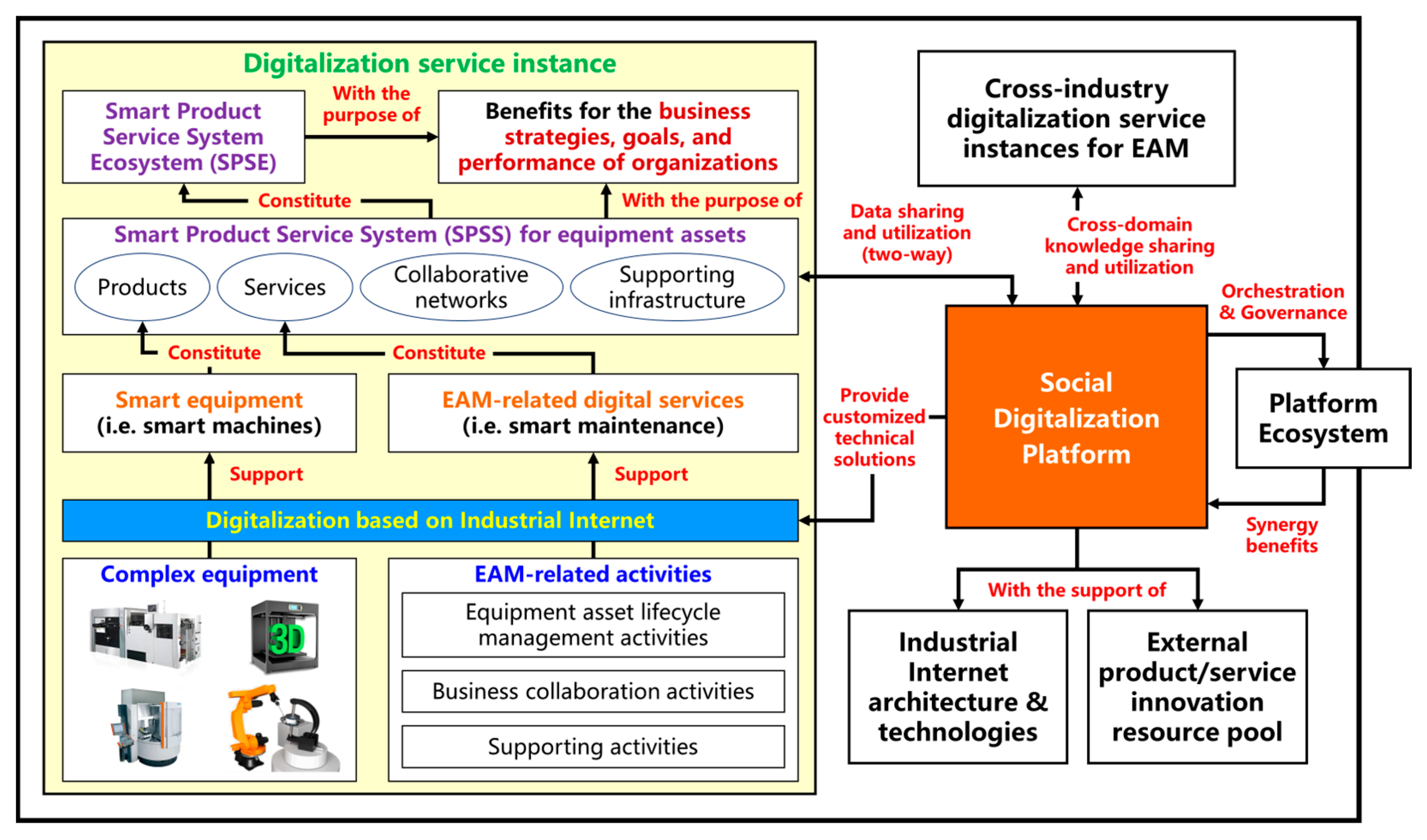

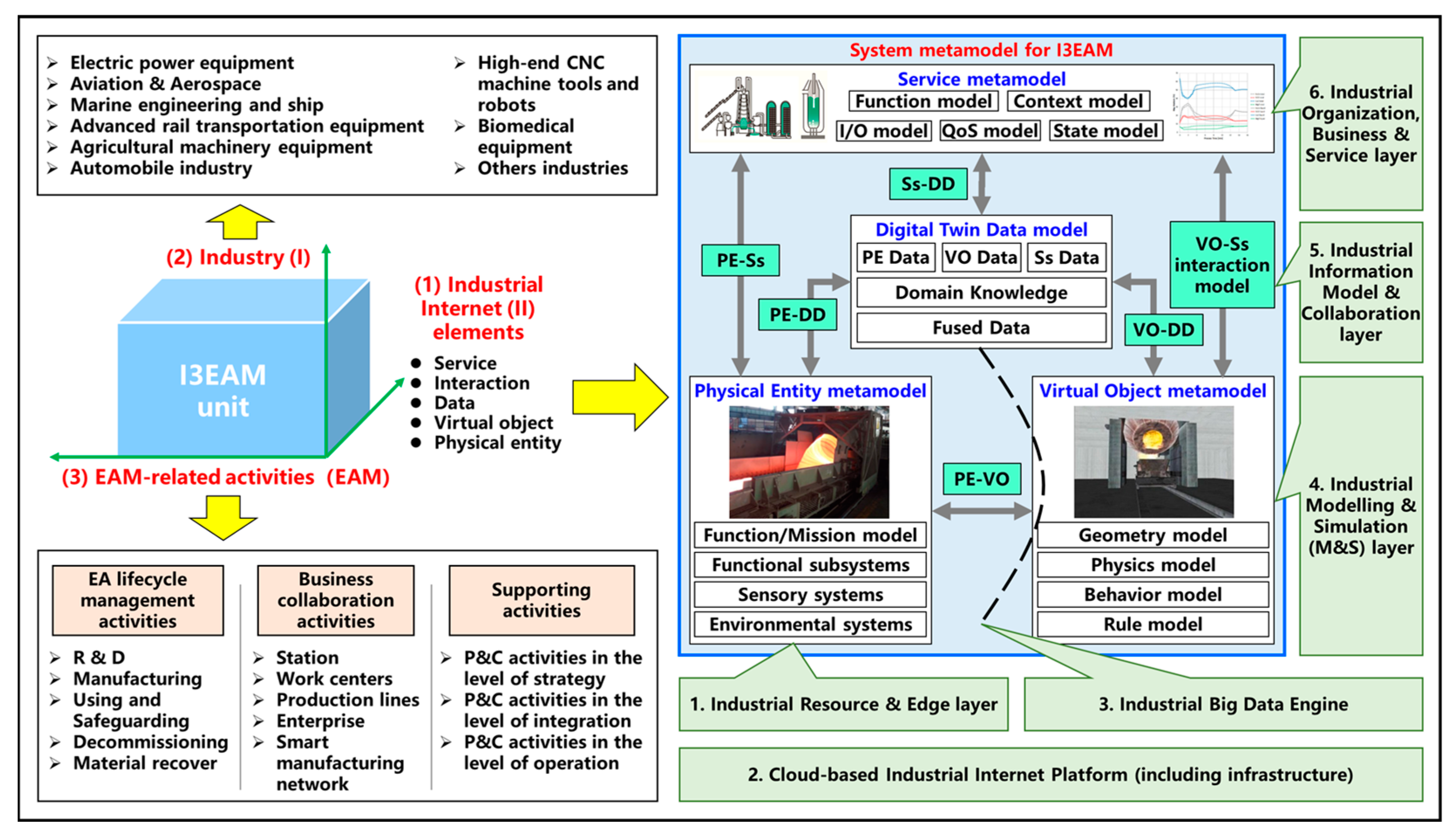
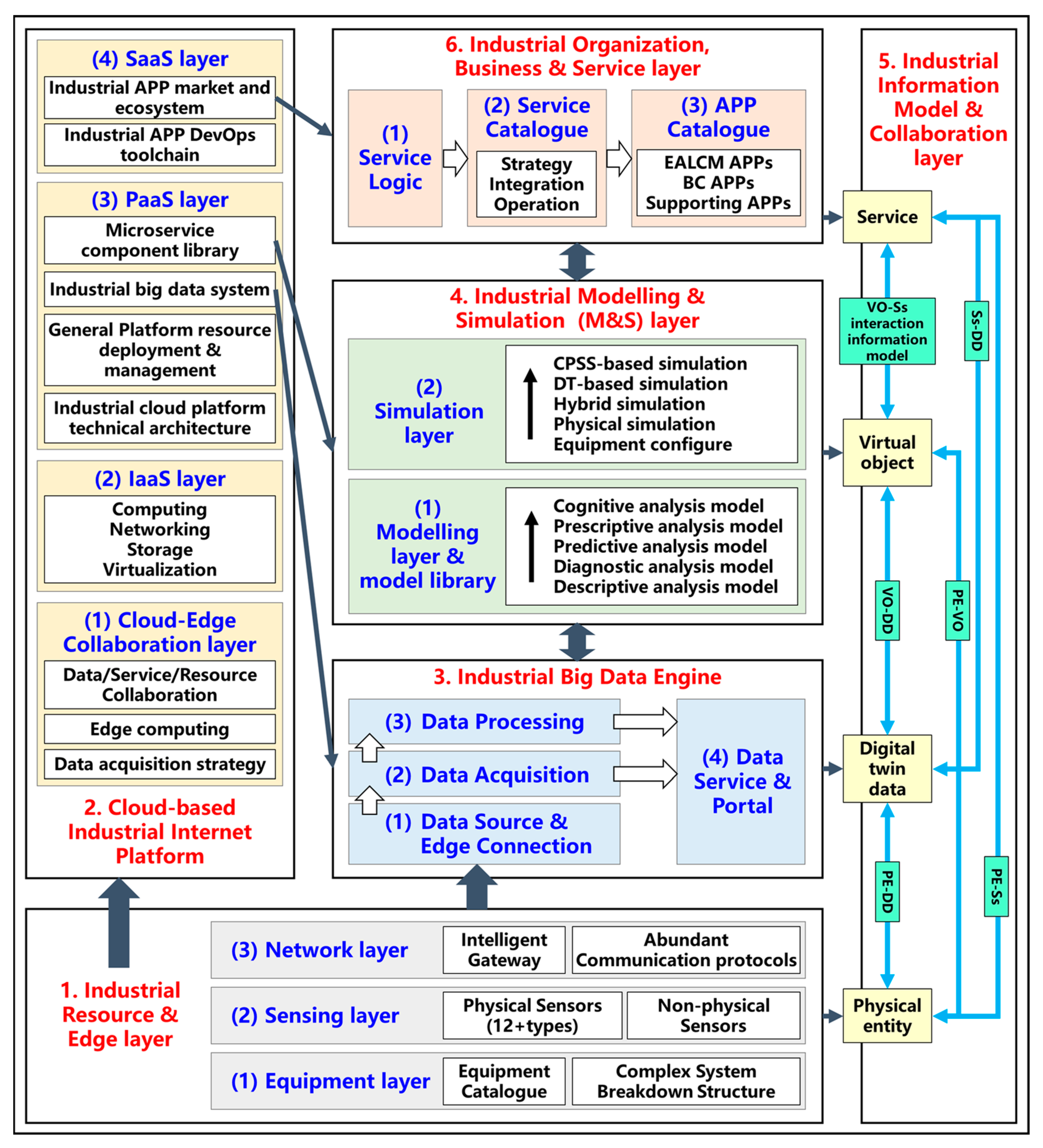
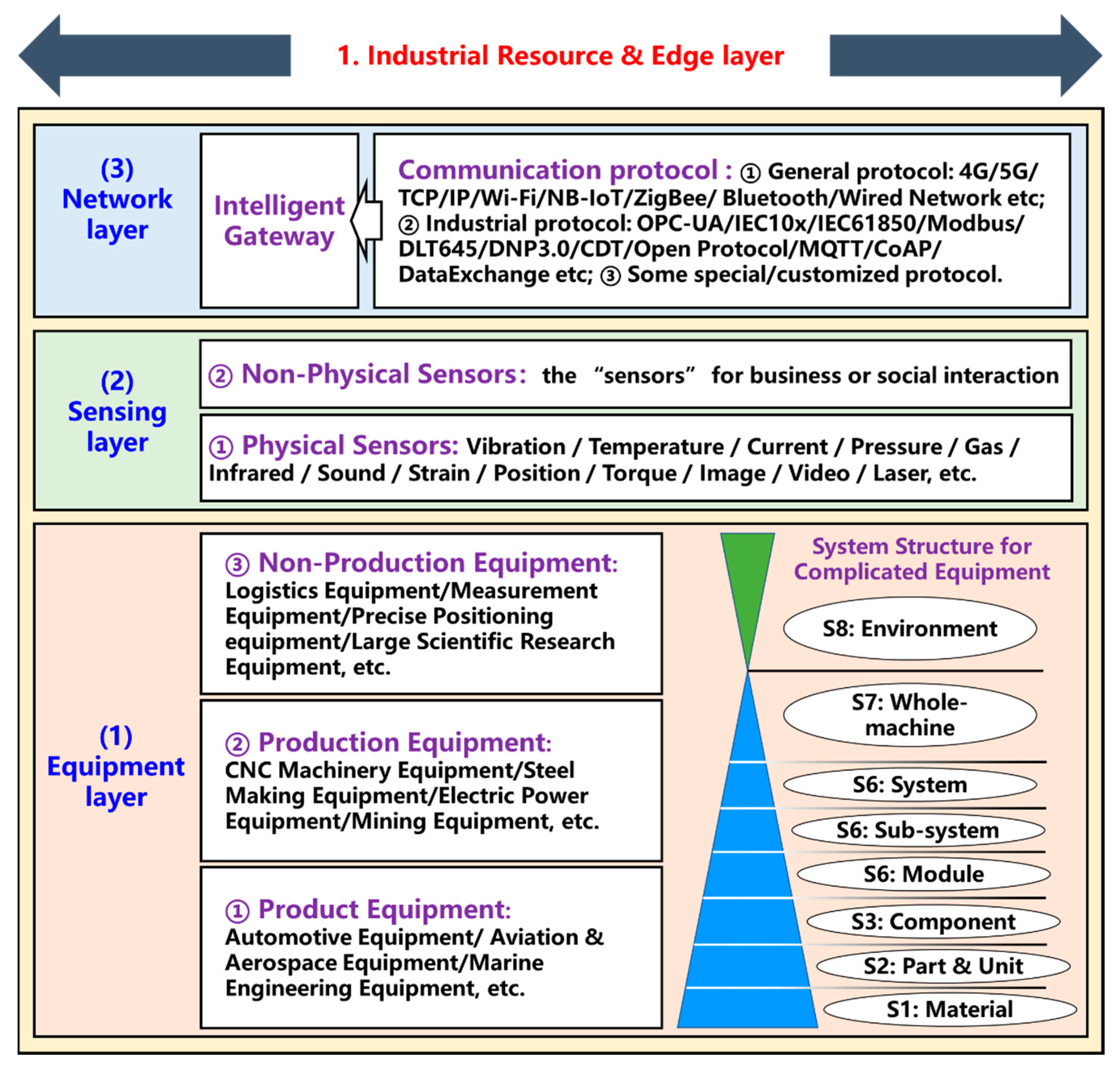
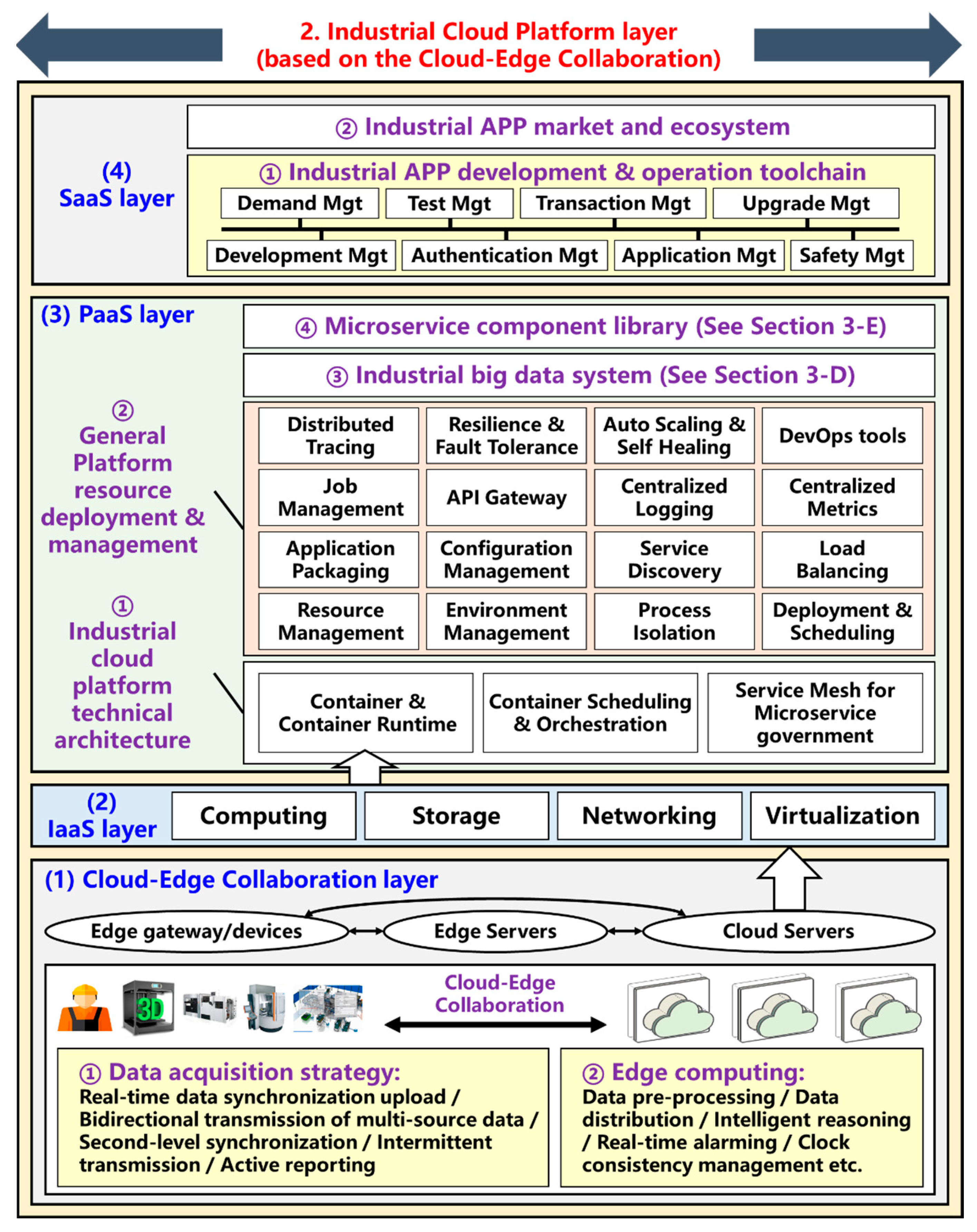
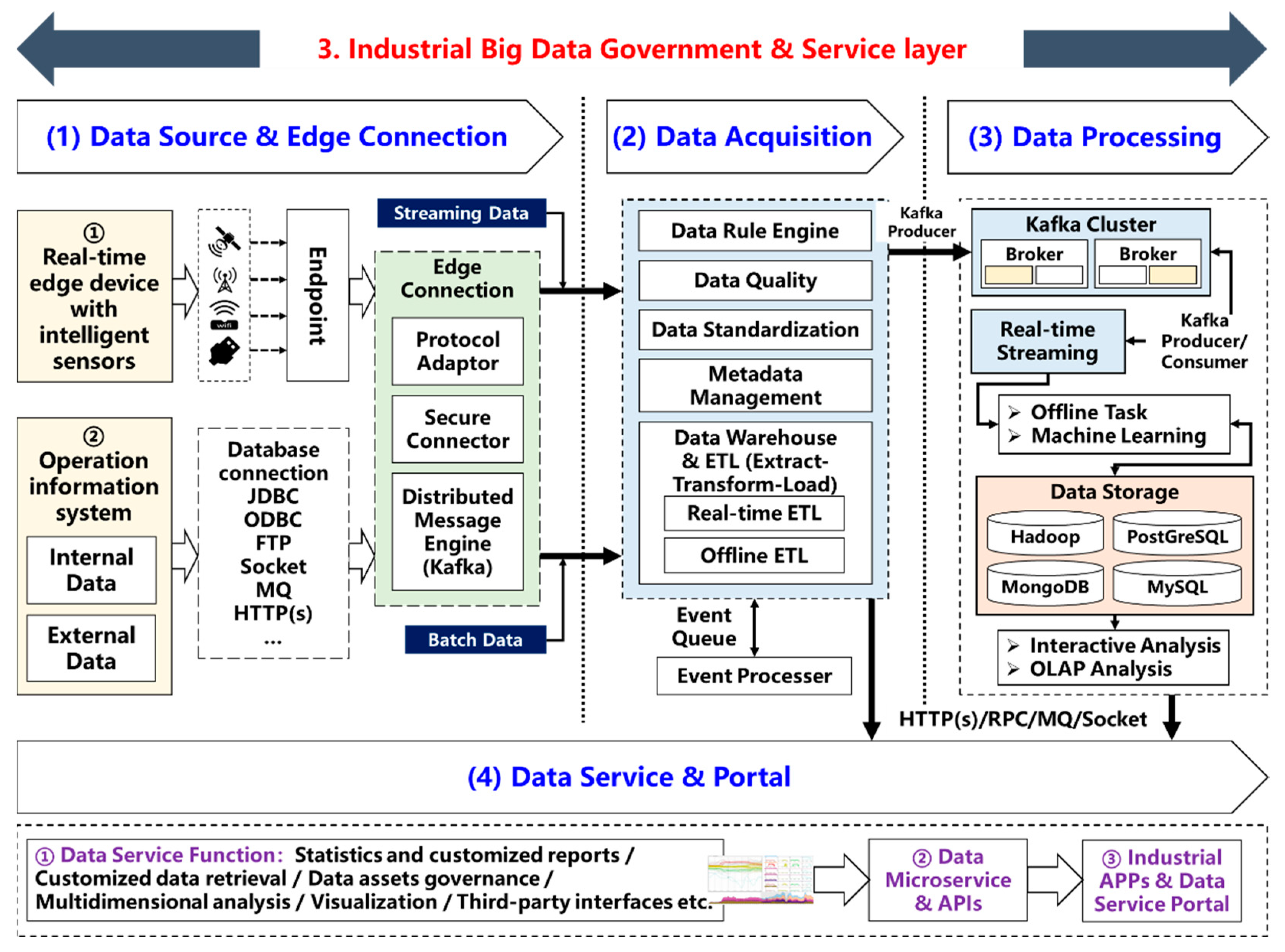
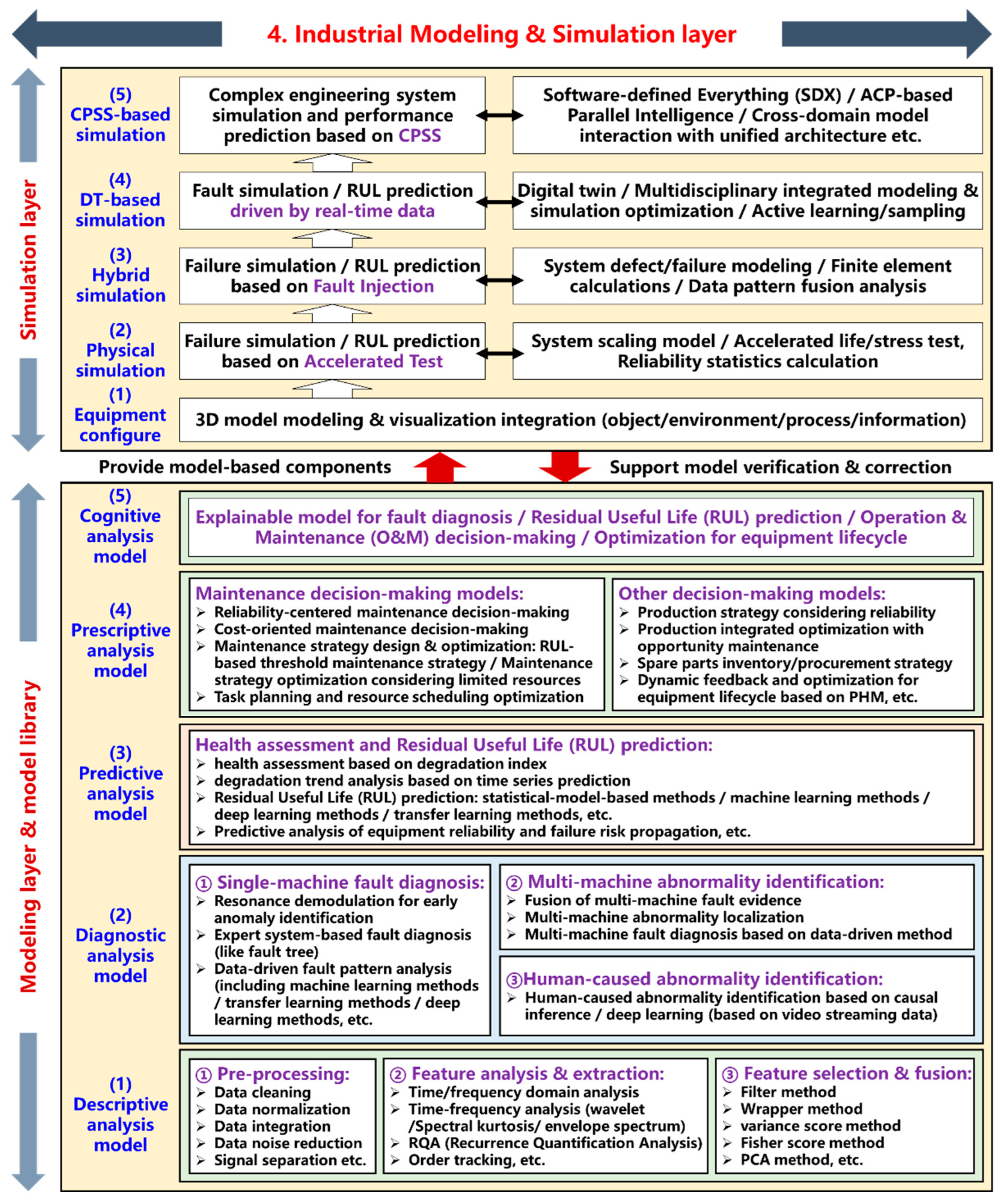


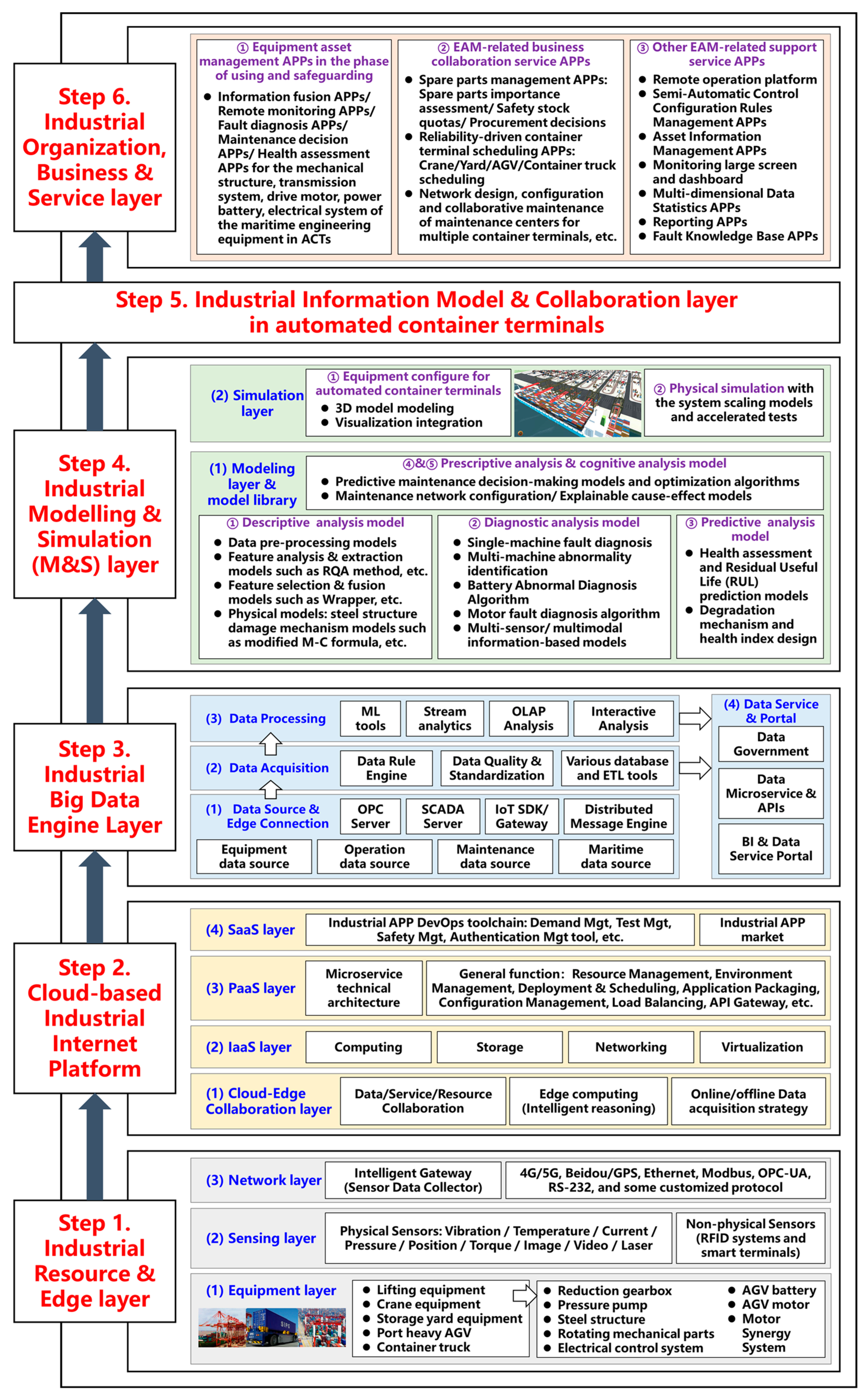
| Category | The State-of-the-Art Technologies | Future Direction |
|---|---|---|
| Data acquisition | Wireless transmission, large-scale low-cost access, intelligent edge acquisition, and multi-modal information fusion | |
| Signal processing | Interpretable physical linkage of signal processing and feature extraction [56] | |
| Fault diagnosis |
| Convergence of physics, data, and expert experience for higher accuracy of pattern recognition [60,66] |
| Health assessment |
| Powerful public data sets [76], cross-scenario adaptive learning methods, and health assessment with consideration of multiple maintenance influences [77] |
| Maintenance decision-making |
| Joint optimization for effective equipment maintenance in the integrated environment with multi-component systems [86], multi-state systems, and multi-layer systems [78] |
| Remote monitoring and co-maintenance |
| Real-time synchronization, multi-discipline, multi-scale, faithful mapping, and high-fidelity modelling for complex equipment and maintenance decision-making environment [6] |
| Service network setting and optimization | Technology-driven business model innovation for data sharing and utilization [97] | |
| Knowledge sharing and privacy preservation | ||
| Equipment optimization driven by reliability data | Joint optimization model and algorithm design which is driven by various collaborative scenarios, missions and utility goals [101] | |
| Business optimization driven by reliability data |
| Name of the Industrial Internet Platform | Technical Framework and Its Characters | Industrial Application |
|---|---|---|
| Siemens MindSphere |
| Aerospace and defense, automotive and transportation, electronics and semiconductors, heavy equipment, and industrial machinery, etc. |
| GE Predix |
| Energy, paper and pulp, chemical, mining and metallurgy, and fertilizer, etc. |
| Microsoft Azure |
| Transportation and logistics, industrial robot, casting, elevator, and food and drink industry, etc. |
| SANY ROOTCLOUD |
| Industrial machinery, discrete manufacturing, steel and non-ferrous metal, chemical, and mining industry, etc. |
| CASICCloud INDICS |
| Aerospace, electronics, machinery, and automotive industry, etc. |
| You-Ye Thingswise iDOS |
| Process manufacturing industries including energy, metallurgy, and material processing, etc. |
| First-Grade Indicator | Second-Grade Indicator | Explanation of the Indicator |
|---|---|---|
| Basic platform service attribute (B) | B1: Talent guarantee | Whether the platform constructor has the necessary industry technology and IT technology capabilities; The number of professionals engaged in the platform construction and operation; The coverage of the professionals’ fields (knowledge and skills for ICT, specific industrial fields, and platform ecology construction &and operation). |
| B2: System Security guarantee | Whether a management system of information security has been built, and whether the hidden dangers can be controlled; Whether effective countermeasures of information security have been constructed; The adoption of technologies for networking security, data security, and industrial access security, etc. | |
| B3: Cost of digitalization service | The level of the total cost for the implementation of I3EAM. | |
| Technical capability for I3EAM (T) | T1: IT resource management capability | The comprehensive performance of IT infrastructure resources (including computing, storage, and network), and the capabilities of cloud-based management and scheduling of IT resources. |
| T2: Industrial equipment adaptation capability | The capability of connection of heterogenous equipment asset resources (including type, sensing scheme, gateway, protocol, and cloud-edge collaboration scheme). | |
| T3: Industrial big data engine performance | The comprehensive performance of industrial big data engine (including data acquisition, data processing, and data service and portal). | |
| T4: Industrial modeling and simulation service capability | The capability of modeling and simulation for Equipment Asset Management (including intelligent algorithms, industrial mechanism models, industrial domain knowledge, digital twins schemes, and human–machine interactions). | |
| T5: Microservice development and government capability | The application level of microservice technical architecture, including capability maturity for microservice development and governance, the number and type of the EAM-related microservice, and the coverage of the needs of I3EAM. | |
| T6: Development environment supporting | The potential for custom development, secondary development and ongoing development of the microservices and industrial APPs (including cost of learning, low-code scheme, the friendliness level of user interfaces, and development toolchain). | |
| T7: Scheme technical architecture performance | The comprehensive performance of the technical architecture for I3EAM, namely the combination and integration scheme of the platform basic services, EAM-related microservices and industrial APPs. | |
| T8: System integration and collaboration capability | The level of compatibility and interoperability with enterprise information systems, the degree of standardization of information models, and the capability of middleware services. | |
| Value of platform application and ecology synergy (A) | A1: Platform scale and activity | The platform scale and activity, including the user scale, user activity, developer scale, developer activity, service provider scale, service provider category, and service provider capability level. |
| A2: Platform application value | The application level of the platform (including the number and type of long-term served industries, and the number and type of long-term served industrial scenarios related to EAM). | |
| A3: Open and sharing mechanism | Whether the platform has the mechanisms and tools for data and knowledge sharing and utilization across the various users and fields. | |
| A4: Platform ecology value | The ecology synergy effect of the platform (including the synergy effect in group company, global company, value chain, industry chain, and platform ecosystem). |
| Fuzzy Number | Linguistic (Abbreviation) | Scale of Fuzzy Number |
|---|---|---|
| 4 | Extremely high influence (EH) | (3.5,4,4) |
| 3 | Very high influence (VH) | (2.5,3,3.5) |
| 2 | High influence (H) | (1.5,2,2.5) |
| 1 | Low influence (L) | (0.5,1,1.5) |
| 0.5 | Very low influence (VL) | (0.5,0.5,1) |
| 0 | No influence (N) | (0,0,0) |
| Indicators | ||
|---|---|---|
| B1 | 2.4254 | 0.0746 |
| B2 | 1.0255 | 0.0315 |
| B3 | 2.8756 | 0.0884 |
| T1 | 1.8564 | 0.0571 |
| T2 | 1.8314 | 0.0563 |
| T3 | 3.5128 | 0.1080 |
| T4 | 3.8550 | 0.1185 |
| T5 | 1.5719 | 0.0483 |
| T6 | 2.4328 | 0.0748 |
| T7 | 2.5513 | 0.0784 |
| T8 | 2.9460 | 0.0906 |
| A1 | 1.6440 | 0.0505 |
| A2 | 1.9866 | 0.0611 |
| A3 | 0.9139 | 0.0281 |
| A4 | 1.1009 | 0.0338 |
| Indicators | FPIS | FNIS |
|---|---|---|
| B1 | (0.0443, 0.0629, 0.0722) | (0.0117, 0.0280, 0.0466) |
| B2 | (0.0099, 0.0177, 0.0246) | (0.0039, 0.0118, 0.0197) |
| B3 | (0.0497, 0.0718, 0.0884) | (0.0000, 0.0221, 0.0442) |
| T1 | (0.0428, 0.0571, 0.0571) | (0.0161, 0.0303, 0.0446) |
| T2 | (0.0281, 0.0422, 0.0563) | (0.0088, 0.0229, 0.0369) |
| T3 | (0.0776, 0.1046, 0.1080) | (0.0337, 0.0607, 0.0877) |
| T4 | (0.0741, 0.1037, 0.1185) | (0.0222, 0.0518, 0.0815) |
| T5 | (0.0076, 0.0196, 0.0317) | (0.0015, 0.0060, 0.0181) |
| T6 | (0.0374, 0.0561, 0.0678) | (0.0000, 0.0187, 0.0374) |
| T7 | (0.0515, 0.0711, 0.0784) | (0.0147, 0.0343, 0.0539) |
| T8 | (0.0566, 0.0792, 0.0906) | (0.0255, 0.0481, 0.0708) |
| A1 | (0.0221, 0.0347, 0.0474) | (0.0063, 0.0190, 0.0316) |
| A2 | (0.0382, 0.0534, 0.0611) | (0.0057, 0.0210, 0.0363) |
| A3 | (0.0114, 0.0184, 0.0255) | (0.0000, 0.0061, 0.0132) |
| A4 | (0.0212, 0.0296, 0.0338) | (0.0000, 0.0042, 0.0127) |
| Alternatives | Sorting | |||
|---|---|---|---|---|
| 0.0494 | 0.0969 | 0.3376 | 4 | |
| 0.0668 | 0.0792 | 0.4574 | 2 | |
| 0.0941 | 0.0442 | 0.6802 | 1 | |
| 0.0700 | 0.0837 | 0.4553 | 3 |
Publisher’s Note: MDPI stays neutral with regard to jurisdictional claims in published maps and institutional affiliations. |
© 2022 by the authors. Licensee MDPI, Basel, Switzerland. This article is an open access article distributed under the terms and conditions of the Creative Commons Attribution (CC BY) license (https://creativecommons.org/licenses/by/4.0/).
Share and Cite
Bao, Y.; Zhang, X.; Zhou, T.; Chen, Z.; Ming, X. Application of Industrial Internet for Equipment Asset Management in Social Digitalization Platform Based on System Engineering Using Fuzzy DEMATEL-TOPSIS. Machines 2022, 10, 1137. https://doi.org/10.3390/machines10121137
Bao Y, Zhang X, Zhou T, Chen Z, Ming X. Application of Industrial Internet for Equipment Asset Management in Social Digitalization Platform Based on System Engineering Using Fuzzy DEMATEL-TOPSIS. Machines. 2022; 10(12):1137. https://doi.org/10.3390/machines10121137
Chicago/Turabian StyleBao, Yuguang, Xianyu Zhang, Tongtong Zhou, Zhihua Chen, and Xinguo Ming. 2022. "Application of Industrial Internet for Equipment Asset Management in Social Digitalization Platform Based on System Engineering Using Fuzzy DEMATEL-TOPSIS" Machines 10, no. 12: 1137. https://doi.org/10.3390/machines10121137
APA StyleBao, Y., Zhang, X., Zhou, T., Chen, Z., & Ming, X. (2022). Application of Industrial Internet for Equipment Asset Management in Social Digitalization Platform Based on System Engineering Using Fuzzy DEMATEL-TOPSIS. Machines, 10(12), 1137. https://doi.org/10.3390/machines10121137








